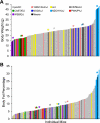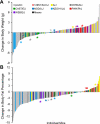Architecture of energy balance traits in emerging lines of the Collaborative Cross
- PMID: 21427413
- PMCID: PMC3118585
- DOI: 10.1152/ajpendo.00707.2010
Architecture of energy balance traits in emerging lines of the Collaborative Cross
Abstract
The potential utility of the Collaborative Cross (CC) mouse resource was evaluated to better understand complex traits related to energy balance. A primary focus was to examine if genetic diversity in emerging CC lines (pre-CC) would translate into equivalent phenotypic diversity. Second, we mapped quantitative trait loci (QTL) for 15 metabolism- and exercise-related phenotypes in this population. We evaluated metabolic and voluntary exercise traits in 176 pre-CC lines, revealing phenotypic variation often exceeding that seen across the eight founder strains from which the pre-CC was derived. Many phenotypic correlations existing within the founder strains were no longer significant in the pre-CC population, potentially representing reduced linkage disequilibrium (LD) of regions harboring multiple genes with effects on energy balance or disruption of genetic structure of extant inbred strains with substantial shared ancestry. QTL mapping revealed five significant and eight suggestive QTL for body weight (Chr 4, 7.54 Mb; CI 3.32-10.34 Mb; Bwq14), body composition, wheel running (Chr 16, 33.2 Mb; CI 32.5-38.3 Mb), body weight change in response to exercise (1: Chr 6, 77.7Mb; CI 72.2-83.4 Mb and 2: Chr 6, 42.8 Mb; CI 39.4-48.1 Mb), and food intake during exercise (Chr 12, 85.1 Mb; CI 82.9-89.0 Mb). Some QTL overlapped with previously mapped QTL for similar traits, whereas other QTL appear to represent novel loci. These results suggest that the CC will be a powerful, high-precision tool for examining the genetic architecture of complex traits such as those involved in regulation of energy balance.
Figures






References
-
- Anunciado RV, Ohno T, Mori M, Ishikawa A, Tanaka S, Horio F, Nishimura M, Namikawa T. Distribution of body weight, blood insulin and lipid levels in the SMXA recombinant inbred strains and the QTL analysis. Exper Animals/Jpn Assoc Laboratory Anim Sci 49: 217–224, 2000 - PubMed
-
- Aylor DL, Valdar W, Foulds-Mathes W, Buus RJ, Verdugo RA, Baric RS, Ferris MT, Frelinger JA, Heise M, Frieman MB, Gralinski LE, Bell TA, Didion JD, Hua K, Nehrenberg DL, Powell CL, Steigerwalt J, Xie Y, Kelada SN, Collins FS, Yang IV, Schwartz DA, Branstetter LA, Chesler EJ, Miller DR, Spence J, Liu EY, McMillan L, Sarkar A, Wang J, Wang W, Zhang Q, Broman KW, Korstanje R, Durrant C, Mott R, Iraqi FA, Pomp D, Threadgill D, Pardo-Manuel de Villena F, Churchill GA. Genetic analysis of complex traits in the emerging Collaborative Cross. Genome Res. 2011. March 15 [Epub ahead of print] PMID: 21406540 - PMC - PubMed
-
- Bennett B, Carosone-Link PJ, Lu L, Chesler EJ, Johnson TE. Genetics of body weight in the LXS recombinant inbred mouse strains. Mamm Genome 16: 764–774, 2005 - PubMed
-
- Bouchard C. Gene-environment interactions in the etiology of obesity: defining the fundamentals. Obesity (Silver Spring, Md) 16, Suppl 3: S5–S10, 2008 - PubMed
Publication types
MeSH terms
Grants and funding
LinkOut - more resources
Full Text Sources
Molecular Biology Databases
Research Materials
Miscellaneous

